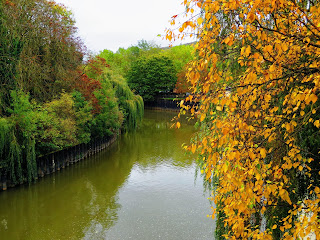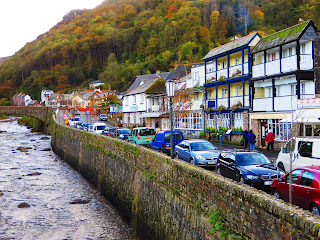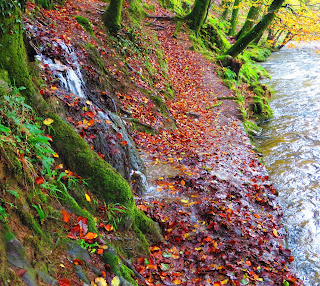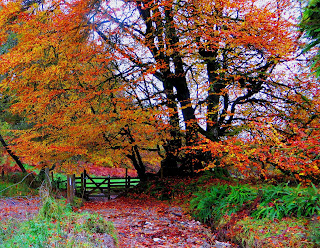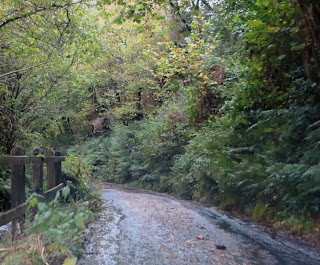Our visit to Bath gave me the opportunity to see some of what I did not have time for during our prior visit there in August (see blog entry, Less Inspiration; More Photos). While Henry met with colleagues and gave a talk at the University in Bath, I moseyed up to a couple of Bath's architectural highlights--the Circus
and Royal Crescent.
and the Circus, along with Gay Street, which links the two, form a masonic key as seen from the air. From the look of the area, and especially the view from the Royal Crescent,
this is clearly a high rent district!
Florence, Italy, with its Ponte Vecchio, is not the only European city to have a "shopping bridge". Bath has its own--Pulteney Bridge, built in the 1770's and spanning the Avon River.
Down the road just a wee bit, the Avon meanders into the countryside.
After the garden was created, Allen had the elder Wood design a mansion, which was built at the top of the hill, within the garden grounds (believe me, it's in the upper left of the photo below).
provides an inviting "inside-drop" (or is that still "backdrop?) for scenes needing hallowed and/or eerie halls.
Had I not become a member of the National Trust, I probably would never have passed this spot nor rambled across the Avon to Prior Park Landscape Garden, a pleasurable garden set on a hillside and created in the 1700's for Ralph Allen, Allen was Bath's Postmaster and later, the Mayor. As he took over more and more of the English postal system in the first half of the 18th century, he introduced reforms that made the system much more efficient. By contracting to handle the mail for so many regions, Allen managed to amass a large fortune. Who knows, Allen could be the last individual to make money delivering the mail--the USPS could use him! In any event, the garden was designed by poet, Alexander Pope, and landscape gardener, Capability Brown (I love that name!), and includes delightful paths,
cascades,
ponds, and a Palladian (named after Andrea Palladio, a Venetian architect from the 1500's) bridge, of which there are only four remaining in the world.
After the garden was created, Allen had the elder Wood design a mansion, which was built at the top of the hill, within the garden grounds (believe me, it's in the upper left of the photo below).
Not too shabby a backyard, I daresay! And, the view is beautiful, even on the grayish day I was there.
With its ancient Roman Baths, distinctive architecture, landscaping, and historical buildings made from honey-hued Bath Stone (Ralph Allen amassed a second fortune from his investment in the local quarries), the entire city of Bath has a well-earned UNESCO designation as a World Heritage site.
And, the Bath restaurants at which we ate are worthy of mention as well--Eleven and Green Park Brasserie, both serving British/European food. The latter restaurant provided an additional unexpected boon--while there, I discovered that the following morning, there would be an artisan market at the Green Park Station next door! It turned out to be one of the best all-around markets from among all the markets I visited during the sabbatical. The market, which claims to be the oldest farmer's market in Britain, sits under the protective overhang of the former Green Park Railway Station
and offers an excellent selection of fresh foods, arts and crafts, antiques, and other bric-a-brac.
Left to my own devices (Henry waited at the hotel), I managed to score several gifts. But, my favorite spot in the market was a organic foods stall--
The National Trust came through once again as we moved on from Bath and drove to the tiny town of Lacock, in Wiltshire. Lacock is known for its abbey, and as a film set for the BBC productions of Pride and Prejudice and Cranford. The abbey also made appearances in Harry Potter and the Philosopher's Stone and Harry Potter and the Half-Blood Prince. I suspect that since the National Trust holds most of the land area of Lacock (donated by the last owner of the Lacock Abbey and estate), it garners some much needed income from the film business. The timber-framed houses provide a pleasant backdrop;
the abbey, which was founded in the 13th century,
Of additional interest is that after the Dissolution of the Monasteries by Henry VIII in the 1500's and the abbey and estate became home to a line of well-to-do families (including William Henry Fox Talbot, inventor of the photographic negative), only part of the abbey was renovated for familial habitation.
This gives even further range to the scope of historical contexts for offer to the film industry!
While in Lacock, I of course could not pass up a stop at a small holiday crafts fair. An older woman (yes, older than I) was selling homemade jams and chutneys. One of the items was damson jam, a fruit with which I was not familiar. I learned from the woman that it is a small plum-like fruit. From her description, I gather it is similar in size to a cherry. As she was wrapping up the various items I purchased (including the damson jam), she explained to me how she was very careful to count exactly how many of the individual damsons she placed in her pot, so she could ensure that she had pulled out the same number of pits, but that she came up two pits short. I had a good chuckle as I imagined the woman counting sponges at the end of a surgery!
Although Henry and I did not get to meander through Oxford during this trip, we stayed at a nearby farmhouse Bed & Breakfast and had outstanding dinners at two restaurants in the outskirts of the city--Fish and The Mole Inn--two more fine Michelin finds.
Despite missing Oxford, we did make it to Stonehenge and Avebury. Stonehenge is by far the most well-known of a group of pre-historic stone formations in this area of England. It stands out on an open field, with easy viewing from the "carriageway" (i.e., main road).
When I visited Stonehenge 40 years ago (yikes, the summer after graduating from college!), we were still able to walk up to and on stop of the stones. Now, a walkway surrounds the henge. What the henge was for remains open to discussion, but the consensus is that it had ritual significance and many believe it was a burial ground. The beginnings of Stonehenge date back to about 8,000 BCE (evidence of timber posts along a wider circumference than the visible stone remains). However, it was not until sometime between 3,000 and 2,000 BCE that the stone circle was created. One can easily see there was some degree of craftwork involved, as the lintels fit relatively evenly along the tops of the vertical stones.
While Stonehenge is regularly overrun with tour buses, Avebury sits quietly about 25 miles away. Although not appearing as "advanced" in construction as Stonehenge, Avebury covers a much wider area, albeit not as well-preserved and more difficult to visualize from the ground. Avebury had consisted of a large stone circle, with two smaller circles situated within the large one. It was also part of a series of formations, which included an avenue marked by rows of stones (known as West Kennet Avenue) and ending at The Sanctuary, another circle of stones and timbers about a mile from the Avebury henge.
Unlike Stonehenge, Avebury has a separate museum, which provides a good deal of background information regarding the area's earliest inhabitants and the Neolithic/Bronze Age formations throughout the region. For example, animal bones from excavations indicated the presence of domesticated dogs and pigs, as well as the use of bones of larger animals (e.g., cows and deer) as raking, digging, and boring tools.
Moving a bit west on the southwestern peninsula of England, Henry and I spent a few days exploring the area in and around Exmoor, a national park on the boundary between North Devon and Somerset. Our base was Minehead, a touristy town on the Bristol Channel, which separates Cornwall, Devon, and Somerset from Wales.
Bryan was a great source of recommendations for eating (mostly Henry, but I never pass up a good meal) and walking (mostly me). Fortunately for us, with our GPS acting up (we subsequently determined that the problem was the electrical connection in the rented Vauxhall, not the GPS), we were able to borrow from Bryan several detailed maps and hike descriptions. Two of our hiking destinations took us west along the coast, through Porlock (where poet Samuel Coleridge wrote his poem Kubla Khan),
Lynton and Lynmouth. The latter two towns abut each other, and together they are known as England's "Little Switzerland". They are situated on a hillside, one town above the other, with a river rushing through them to the Channel. Rather than Switzerland, the setting reminded me more of Port Wenn, the fictional Cornwall seaside village in British television's Doc Martin.
(check out this extreme tide range!)

This "clapper bridge" probably dates back to about 1,000 BCE, but has washed out several times over the past two years. It washed out just a day or two before during the recent storm. We learned that the steps were repaired several weeks prior, after an earlier seasonal storm. Normally, hikers can cross the river and return to Withypool on the opposite side. I had the opportunity to cross the river earlier during my hike. It would have been quite an interesting feat to cross back at the Tarr Steps to meet Henry and the car! But, all was well upon my arrival--Henry was warmly tucked away next to the bar of the Tarr Steps Farm Inn, a five-star luxury accommodation next to the Steps.
Moving a bit west on the southwestern peninsula of England, Henry and I spent a few days exploring the area in and around Exmoor, a national park on the boundary between North Devon and Somerset. Our base was Minehead, a touristy town on the Bristol Channel, which separates Cornwall, Devon, and Somerset from Wales.
Because it has a beach (unlike many of the other coastal towns along the channel, many Brits and Germans vacation there with their families. We stayed at a Bed & Breakfast called The Parks Guesthouse--not named after the owners, but after the street on which it sits, "The Parks". The owners, Bryan and Sarah, were quite a kick--great senses of humor and lacking the stiff upper lip staidness of the British stereotype. Sarah's day job is in nursing; Bryan left his London job with the railroad about 12 years ago, and now runs the B & B and has a regular local radio show. Talk about switching gears!
Bryan was a great source of recommendations for eating (mostly Henry, but I never pass up a good meal) and walking (mostly me). Fortunately for us, with our GPS acting up (we subsequently determined that the problem was the electrical connection in the rented Vauxhall, not the GPS), we were able to borrow from Bryan several detailed maps and hike descriptions. Two of our hiking destinations took us west along the coast, through Porlock (where poet Samuel Coleridge wrote his poem Kubla Khan),
Lynton and Lynmouth. The latter two towns abut each other, and together they are known as England's "Little Switzerland". They are situated on a hillside, one town above the other, with a river rushing through them to the Channel. Rather than Switzerland, the setting reminded me more of Port Wenn, the fictional Cornwall seaside village in British television's Doc Martin.
(check out this extreme tide range!)
Our lunch spot, a very English pub called The Village Inn,
could have been Al Large's restaurant in the same show! The beer battered fish and crispy "chips" ranked among the best we had over the entire four-month sabbatical.
My walk around the Valley of Rocks, just to the west of the two towns,
put me all the more into Port Wenn mode. Okay, this photo looks a little more "Switzerlandish":
I did not see any lonely goatherd high on a hill (apologies to Rodgers and Hammerstein) (oops, The Sound of Music took place in Austria). Rather, the grazing goats found impossible-to-reach cliff ledges on their very own!
My next walk was in Heddon Valley, a few miles to the west of the Valley of Rocks. The trail follows the Heddon River
to Heddon's Mouth,where (duh) the river flows into the Bristol Channel.
The National Trust gets another nod here, as this area is one more of many open space areas owned and preserved by that organization. Thank you, thank you again and again to guidebooks and the Internet for putting the National Trust (and English Heritage) on my radar! I'm already checking out the National Trust of Australia in anticipation of Henry's and my upcoming trip to South Australia in 2014! We'll see if visits to wineries in the Barossa Valley and Coonawarra regions end up trumping the National Trust offerings.
While I enjoyed these hikes very much, the true highlight hike took me from Withypool (what a great name for an English village!) to the Tarr Steps. I was forewarned that the wet weather in the area (that's why some of the above and below photos are darkish and/or have washed out sky) would make this hike rather muddy.
I nevertheless ventured off in my mesh (albeit "waterproof") Merrell hiking shoes. I would have been much better off with Wellies (Wellington boots) and ankle/leg gaiters.
Yes, these photos are of the trail! At one point, I was mired mid-calf in mud, feeling the same sucking one feels when standing barefoot in a fast-running river (as I did in the Colorado River during my Grand Canyon rafting trip last spring) or in ocean undertoe. Although both feet, socks, and pant legs ended up muddy and wet, my waterproof hiking shoes, albeit caked with mud, remained relatively dry on the outside, as advertised!
In any event, the hike along the River Barle was a wonderful jaunt,

and the end-point--the Tarr Steps--where Henry arranged to meet me with the rental car, was a treat.
This "clapper bridge" probably dates back to about 1,000 BCE, but has washed out several times over the past two years. It washed out just a day or two before during the recent storm. We learned that the steps were repaired several weeks prior, after an earlier seasonal storm. Normally, hikers can cross the river and return to Withypool on the opposite side. I had the opportunity to cross the river earlier during my hike. It would have been quite an interesting feat to cross back at the Tarr Steps to meet Henry and the car! But, all was well upon my arrival--Henry was warmly tucked away next to the bar of the Tarr Steps Farm Inn, a five-star luxury accommodation next to the Steps.
With his espresso, laptop, spiral notebook, and three-by-five cards in hand, Henry had no worries as to when I would eventually show up! But, to be honest, Henry had the really tough job of driving along the extremely narrow and windy roads in the region.
Reading our detailed maps and getting directions from the local merchants provided no indication of what the roads themselves were going to look like. The map legend claimed that "M" roads are motorways, "A" roads are main thoroughfares, just one step down from "M", and "B" roads are secondary roads. Not so at all in reality. The A39, which traverses a portion of the southwest peninsula, narrowed from a major road to barely a single lane in width!
Eek!!! In other spots, the roads were not only amazingly narrow; they also sported close to 180 degree turns and 25% gradients. The tall hedgerows abutting both sides of the road made it nearly impossible not to brush against them when lorries passed in the opposite direction. Henry and I regularly joked about the 60 miles per hour signs posted outside village and town limits. Henry was happy getting up to one-third that speed on these roads. I can understand how he got tired out from our drives! Henry is my hero for being the driver extraordinaire!
Exmoor is well worth a return visit--on another sabbatical, perhaps. No, I prefer not to wait that long! In the meantime, we have fond memories of beautiful countryside, and some fine meals as well (Hathaways--upscale eats in the attractive little town of Dunster
(unfortunately, the National Trust's Dunster Castle and similar properties were already closed for the winter); Old Ship Aground--formerly a rundown dive transformed into a gastropub and inn in Minehead; and Fausto's--middle-scale Italian restaurant with a sister take-out pizzeria, also in Minehead. In addition, we will fondly recall the fishmonger at one of the region's farmer's markets, whose moniker is The Codfather.
Who says the Brits have no sense of humor?
Although Henry and I are now home in Del Mar, please check back for one or two more installments of the 2013 Sabbatical Shmooze!









